
King William Street is a street in the City of London, the historic nucleus and modern financial centre of London. It is a two-way street linking Lombard Street, at its northern end, with London Bridge, which marks the start of the start of the A3 route to Portsmouth.

St Mary Woolnoth is an Anglican church in the City of London, located on the corner of Lombard Street and King William Street near Bank junction. The present building is one of the Queen Anne Churches, designed by Nicholas Hawksmoor. The parish church continues to be actively used for services, with Holy Communion every Tuesday. St Mary Woolnoth lies in the ward of Langbourn.

St Mary Aldermary, is an Anglican guild church located on Bow Lane at the junction with Watling St, in the City of London. Of medieval origin, rebuilding began under the Tudor Henry VIII in 1510 and was not finished until the reign of the Stuart monarch Charles I in 1632. Severely damaged just 33 years later during the Great Fire of London in 1666, it was rebuilt once more, this time by the office of Sir Christopher Wren. Unlike most of Wren's City churches, St Mary Aldermary was reconstructed in the Gothic style, an outstanding example of the first — 17th century — Gothic Revival. Nearly a millennium after its foundation SMA continues to offer a place for contemplation with pre-work 8am gatherings three times a week and after work at 6pm on Wednesday.
St Margaret Lothbury is a Church of England parish church on Lothbury in the City of London; it spans the boundary between Coleman Street Ward and Broad Street Ward. Recorded since the 12th century, the church was destroyed in the Great Fire of London in 1666 and rebuilt by the office of Sir Christopher Wren. St Margaret Lothbury still serves as a parish church, as well as being the official church of five Livery Companies, two Ward Clubs and two Professional Institutes. It also has connections with many local finance houses, all of which hold special services each year.

St Nicholas Cole Abbey is a church in the City of London located on what is now Queen Victoria Street. Recorded from the twelfth century, the church was destroyed in the Great Fire of London in 1666 and rebuilt by the office of Sir Christopher Wren. The church suffered substantial bomb damage from German bombs during the London Blitz in the Second World War and was reconstructed by Arthur Bailey in 1961–2.

St Lawrence Jewry next Guildhall is a Church of England guild church in the City of London on Gresham Street, next to Guildhall. It was destroyed in the Great Fire of London in 1666, and rebuilt to the designs of Sir Christopher Wren. It is the official church of the Lord Mayor of London.
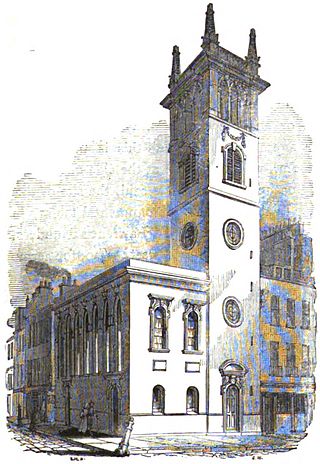
All Hallows Bread Street was a parish church in the Bread Street ward of the City of London, England. It stood on the east side of Bread Street, on the corner with Watling Street. First mentioned in the 13th century, the church was destroyed in the Great Fire of London in 1666. The church was rebuilt by the office of Sir Christopher Wren and demolished in 1876.
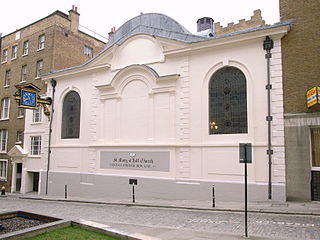
St Mary-at-Hill is an Anglican parish church in the Ward of Billingsgate, City of London. It is situated on Lovat Lane, a cobbled street off Eastcheap.

St Mary Abchurch is a Church of England church off Cannon Street in the City of London. Dedicated to the Blessed Virgin Mary, it is first mentioned in 1198–1199. The medieval church was destroyed in the Great Fire of London in 1666, and replaced by the present building.
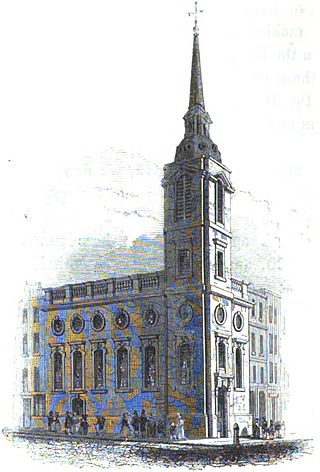
St Benet Gracechurch, so called because a haymarket existed nearby (Cobb), was a parish church in the City of London. First recorded in the 11th century, it was destroyed in the Great Fire of London of 1666 and rebuilt by the office of Sir Christopher Wren. The church was demolished in 1868.
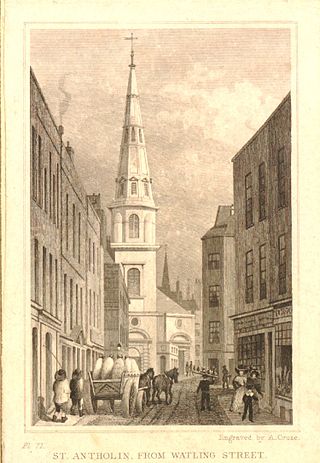
St Antholin, Budge Row, or St Antholin, Watling Street, was a church in the City of London. Of medieval origin, it was rebuilt to the designs of Sir Christopher Wren, following its destruction in the Great Fire of London in 1666. The 17th-century building was demolished in 1874.
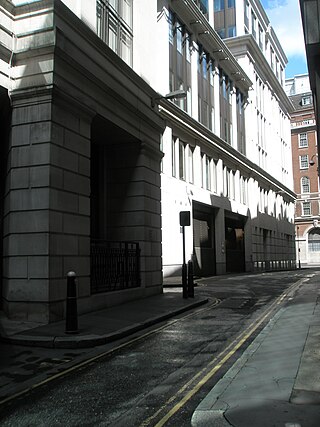
St Nicholas Acons was a parish church in the City of London. In existence by the late 11th century, it was destroyed during the Great Fire of London of 1666 and not rebuilt.

Langbourn is one of the 25 ancient wards of the City of London. It reputedly is named after a buried stream in the vicinity.
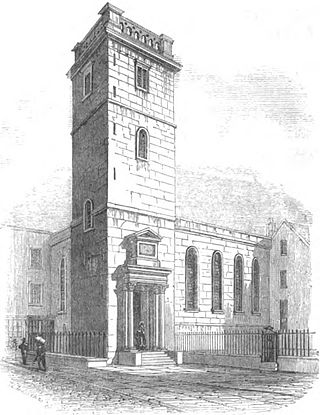
All Hallows Lombard Street, also seen with the descriptor Gracechurch Street, was a parish church in the City of London. It stood behind thin buildings fronting both streets in Langbourn Ward, The west and south sides faced into Ball Alley. Of medieval origin, it was rebuilt after the Great Fire of London. It was demolished in 1937; its tower was reconstructed at Twickenham as part of the new church of All Hallows, which also received its bells and complete interior fittings.
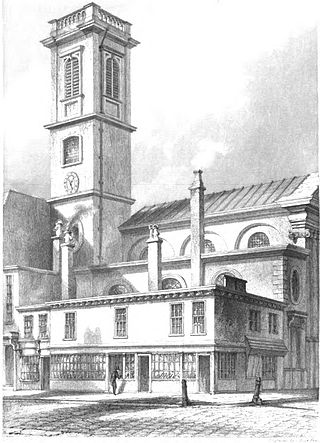
St Dionis Backchurch was a parish church in the Langbourn ward of the City of London. Of medieval origin, it was rebuilt after the Great Fire of London to the designs of Christopher Wren and demolished in 1878.

St Mary Woolchurch Haw was a parish church in the City of London, destroyed in the Great Fire of London of 1666 and not rebuilt. It came within the ward of Walbrook.

St. Leonard, Eastcheap, sometimes referred to as St Leonard Milkchurch, was a parish church in the City of London. Of medieval origin, it was destroyed in the Great Fire of London in 1666 and not rebuilt. The site of the church was retained as a graveyard.

Lombard Street is a street notable for its connections with the City of London's merchant, banking and insurance industries, stretching back to medieval times.





















